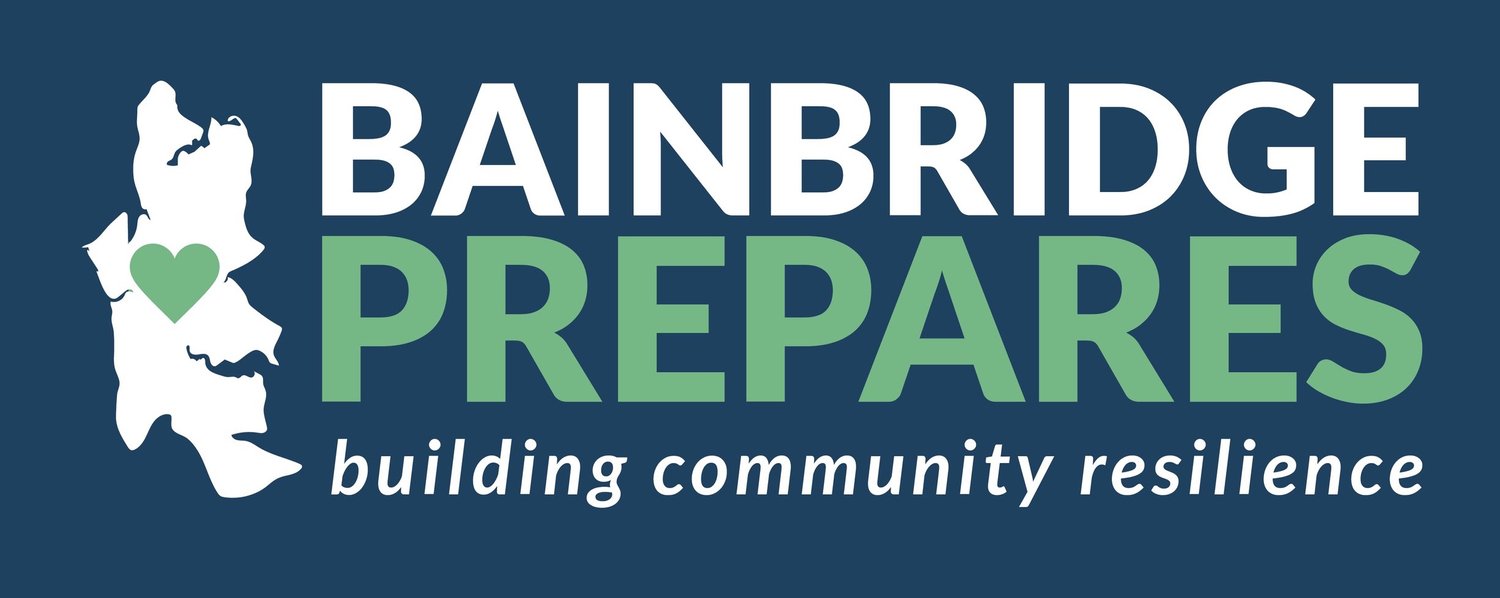Team Spotlight: Disaster Hubs Management
 Each month, we will be featuring a different Bainbridge Prepares team so you can get to know them and their mission. Today’s spotlight is on the Disaster Hubs Management (Hubs) Team led by Phil Fergusson, Kathy Hannula-Bral, and Alice Ostdiek.
Each month, we will be featuring a different Bainbridge Prepares team so you can get to know them and their mission. Today’s spotlight is on the Disaster Hubs Management (Hubs) Team led by Phil Fergusson, Kathy Hannula-Bral, and Alice Ostdiek.
MissionThe Hubs Team’s primary mission is to support and enhance the City’s disaster response capabilities by making sure that, prior to a disaster, Hubs are resourced and staffed throughout the island. Specifically, the team prepares and places supply caches and operation instructions in the designated Hubs so that trained volunteers will be able to provide services to the community. During a disaster, the Disaster Hubs will provide official information from the City’s Emergency Operations Center and serve as neighborhood locations for community members to share resources and help one another, enabling the City, Bainbridge Island Fire Department (BIFD), and other governmental emergency response partners to focus on higher-level needs.The primary services offered at Hubs are medical; shelter and feeding; reunification of families; and communications and information services.PreparationThe team is in the process of developing a resilient network of volunteers and Disaster Hub sites. This requires constant refinement of operating procedures, training, and volunteer engagement. A core group of approximately 12 to 15 volunteers has been engaged in planning efforts, along with key members of virtually every other Bainbridge Prepares team. Every credentialed Bainbridge Prepares volunteer will be assigned to report to a Disaster Hub during an emergency.In June 2022, in conjunction with the regional Cascadia Rising exercise, Hubs ran their first full-scale simulation of a disaster and the response at a Disaster Hub, an exercise that provided the team with critical feedback.The team has a detailed plan for refreshing supplies at the Hubs and for updating the operational instructions included in each supply cache. In addition, the team is pursuing and training more volunteers. The team especially needs volunteers to help with site safety and operations and to assist with the administrative and management aspects of running the Disaster Hubs.Accomplishments and Objectives
Running a full-scale exercise during Cascadia Rising was a huge accomplishment. It demonstrated to the public —and to the Hubs Team—just what it will take to provide critical services in the aftermath of a disaster.
Three Disaster Hubs will be in a “ready” state by the end of this year. That means that the partnership among the City, BIFD, and Bainbridge Prepares will have cached supplies and detailed operational plans to run three key Disaster Hubs if a major earthquake or some other disaster were to hit tomorrow. Once those three are operational, Hubs will spend the next year supplying and planning for the remaining twelve Hubs.
For 2023, Hubs plans to invite neighborhoods organized through Map Your Neighborhoods to visit their nearest Disaster Hub sites and acquaint themselves with the services they could anticipate during a disaster. A side goal is for the activity to inspire many residents to prepare their own homes and businesses, join the Map Your Neighborhood effort, and sign up to get training and to volunteer at the Disaster Hub in the event of an emergency.
Also rolling out in 2023 will be Hubs-specific training programs for each of the Hubs-responding BP teams, such as BIEMRs, MRC, BEARS, and CERT. In addition, all volunteers—whether they sign up to work at a registration desk, provide first aid, prepare food, supervise a shelter space, direct traffic, or run a satellite internet link—will soon be able to take a Hubs orientation training to give them all the same basic familiarity with Hub operations.
The main lesson learned during the 2022 Cascadia Ring exercise was that it takes many people to run the Hubs, from staffing a single shift to assisting with training exercises as actors. The bottom line is that neighborhoods need to be more engaged. Fourteen Hubs will require many more people than we currently have—consider that, during a major disaster, as many as a third of trained staff could be injured, off-island, or be occupied caring for family members.A strong Hub Network begins with engaging all of the neighborhoods and raising awareness about how we—as a community—will come together to respond to a disaster.
Anyone interested in working at a Disaster Hub is encouraged to reach out to the Bainbridge Prepares team (or teams) that best fits their interest or skill set. If you have a medical background or interest in first aid, join MRC or BIEMRs. If you have an interest in amateur radio, join BEARs. If you love animals, join our Domestic Animal Care team. If you are structural engineer or have construction skills, join the Damage and Assessment Team. All of these teams will play critical roles during an emergency. And if you don’t know where to get started, sign up for CERT training, a good baseline for all of our volunteers at a Disaster Hub, which will help you fill many different roles.
Finally, everyone is encouraged to join or organize their local Map Your Neighborhood group.
Watch a video on the Cascadia Rising Hubs exercise here:[videopress iAzn6Tyj]Featured photo shows BP Founder Scott James and Hubs Lead Alice Ostdiek at Cascadia Rising exercise.
